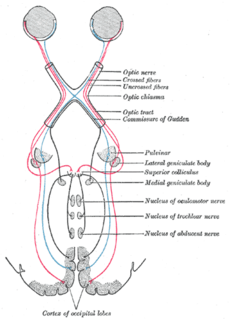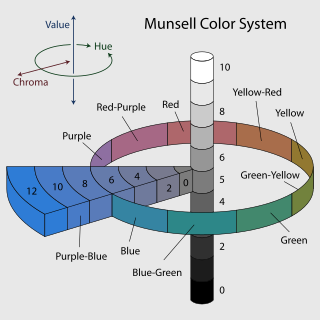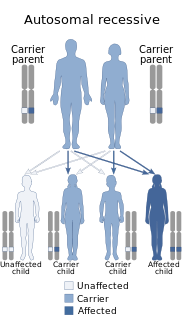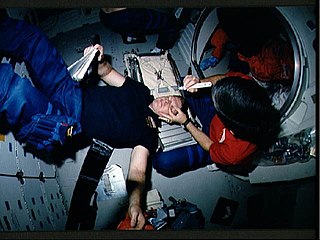 W
WAmblyopia, also called lazy eye, is a disorder of sight in which the brain fails to process inputs from one eye and over time favors the other eye. It results in decreased vision in an eye that otherwise typically appears normal. Amblyopia is the most common cause of decreased vision in a single eye among children and younger adults.
 W
WAn anopsia is a defect in the visual field. If the defect is only partial, then the portion of the field with the defect can be used to isolate the underlying cause.
 W
WAssociative visual agnosia is a form of visual agnosia. It is an impairment in recognition or assigning meaning to a stimulus that is accurately perceived and not associated with a generalized deficit in intelligence, memory, language or attention. The disorder appears to be very uncommon in a "pure" or uncomplicated form and is usually accompanied by other complex neuropsychological problems due to the nature of the etiology. Afflicted individuals can accurately distinguish the object, as demonstrated by the ability to draw a picture of it or categorize accurately, yet they are unable to identify the object, its features or its functions.
 W
WBinasal hemianopsia is the medical description of a type of partial blindness where vision is missing in the inner half of both the right and left visual field. It is associated with certain lesions of the eye and of the central nervous system, such as congenital hydrocephalus.
 W
WBitemporal hemianopsia, is the medical description of a type of partial blindness where vision is missing in the outer half of both the right and left visual field. It is usually associated with lesions of the optic chiasm, the area where the optic nerves from the right and left eyes cross near the pituitary gland.
 W
WChiasmal syndrome is the set of signs and symptoms that are associated with lesions of the optic chiasm, manifesting as various impairments of the sufferer's visual field according to the location of the lesion along the optic nerve. Pituitary adenomas are the most common cause; however, chiasmal syndrome may be caused by cancer, or associated with other medical conditions such as multiple sclerosis and neurofibromatosis.
 W
WChildhood blindness is an important cause contributing to the burden of blindness. Blindness in children can be defined as a visual acuity of <3/60 in the eye with better vision of a child under 16 years of age. This generally means that the child cannot see something 10 feet away, that another child could see if it was 200 feet away.
 W
WColor blindness is the decreased ability to see color or differences in color. It can impair such tasks as selecting ripe fruit, choosing clothing, and reading traffic lights. Color blindness may make some educational activities more difficult. However, problems are generally minor, and most color-blind people adapt. People with total color blindness (achromatopsia) may also be uncomfortable in bright environments and have decreased visual acuity.
 W
WThis is a list of people with color blindness, meaning they have a decreased ability to see color or differences in color.
 W
WDiplopia is the simultaneous perception of two images of a single object that may be displaced horizontally, vertically, diagonally, or rotationally in relation to each other. It is usually the result of impaired function of the extraocular muscles, where both eyes are still functional, but they cannot turn to target the desired object. Problems with these muscles may be due to mechanical problems, disorders of the neuromuscular junction, disorders of the cranial nerves that innervate the muscles, and occasionally disorders involving the supranuclear oculomotor pathways or ingestion of toxins.
 W
WAn eyeborg or eye-borg is a body modification apparatus which fits on the wearer's head, and is designed to allow people to perceive color through sound waves. It works with a head-mounted antenna that senses the colors directly in front of a person, and converts them in real-time into sound waves through bone conduction.
 W
WThe Farnsworth–Munsell 100 Hue Color Vision test is a test of the human visual system often used to test for color blindness. The system was developed by Dean Farnsworth in the 1940s and it tests the ability to isolate and arrange minute differences in various color targets with constant value and chroma that cover all the visual hues described by the Munsell color system. There are several variations of the test, one featuring 100 color hues and one featuring 15 color hues. Originally taken in an analog environment with physical hue tiles, the test is now taken from computer consoles. An accurate quantification of color vision accuracy is particularly important to designers, photographers and colorists, who all rely on accurate color vision to produce quality content.
 W
WHemianopsia, or hemianopia, is a visual field loss on the left or right side of the vertical midline. It can affect one eye but usually affects both eyes.
 W
WMacular degeneration, also known as age-related macular degeneration, is a medical condition which may result in blurred or no vision in the center of the visual field. Early on there are often no symptoms. Over time, however, some people experience a gradual worsening of vision that may affect one or both eyes. While it does not result in complete blindness, loss of central vision can make it hard to recognize faces, drive, read, or perform other activities of daily life. Visual hallucinations may also occur but these do not represent a mental illness.
 W
WMacular telangiectasia a type of eye disorder of the macula, the area near the center of the retina, causing a gradual deterioration of central vision, and interfering with tasks such as reading and driving.
 W
WMonochromacy is the ability of organisms or machines to perceive only light intensity, without respect to spectral composition (color). Organisms with monochromacy are called monochromats.
 W
WNyctalopia, also called night-blindness, is a condition making it difficult or impossible to see in relatively low light. It is a symptom of several eye diseases. Night blindness may exist from birth, or be caused by injury or malnutrition. It can be described as insufficient adaptation to darkness.
 W
WOguchi disease, is an autosomal recessive form of congenital stationary night blindness associated with fundus discoloration and abnormally slow dark adaptation.
 W
WProsopagnosia, also called face blindness, is a cognitive disorder of face perception in which the ability to recognize familiar faces, including one's own face (self-recognition), is impaired, while other aspects of visual processing and intellectual functioning remain intact. The term originally referred to a condition following acute brain damage, but a congenital or developmental form of the disorder also exists, with a prevalence rate of 2.5%. The specific brain area usually associated with prosopagnosia is the fusiform gyrus, which activates specifically in response to faces. The functionality of the fusiform gyrus allows most people to recognize faces in more detail than they do similarly complex inanimate objects. For those with prosopagnosia, the new method for recognizing faces depends on the less sensitive object-recognition system. The right hemisphere fusiform gyrus is more often involved in familiar face recognition than the left. It remains unclear whether the fusiform gyrus is only specific for the recognition of human faces or if it is also involved in highly trained visual stimuli.
 W
WQuadrantanopia, quadrantanopsia, refers to an anopia affecting a quarter of the field of vision.
 W
WRetinal migraine is a retinal disease often accompanied by migraine headache and typically affects only one eye. It is caused by ischaemia or vascular spasm in or behind the affected eye.
 W
WScintillating scotoma is a common visual aura that was first described by 19th-century physician Hubert Airy (1838–1903). It may precede a migraine headache, but can also occur acephalgically. It is often confused with retinal migraine, which originates in the eyeball or socket.
 W
WScleral reinforcement is a surgical procedure used to reduce or stop further macular damage caused by high myopia, which can be degenerative.
 W
WA scotoma is an area of partial alteration in the field of vision consisting of a partially diminished or entirely degenerated visual acuity that is surrounded by a field of normal – or relatively well-preserved – vision.
 W
WA vision disorder is an impairment of the sense of vision.
 W
WSpaceflight-induced visual impairment is hypothesized to be a result of increased intracranial pressure. The study of visual changes and intracranial pressure (ICP) in astronauts on long-duration flights is a relatively recent topic of interest to Space Medicine professionals. Although reported signs and symptoms have not appeared to be severe enough to cause blindness in the near term, long term consequences of chronically elevated intracranial pressure is unknown.
 W
WVisual snow, also known as visual static, is a condition in which people see white or black dots in parts or the whole of their visual fields. The condition is typically always present and can last years.